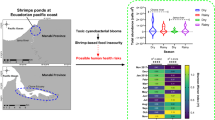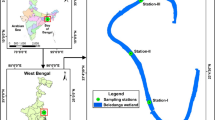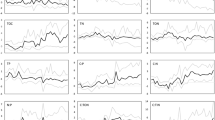Abstract
There is broad consensus that cyanobacterial blooms will increase in severity, frequency, and duration under future climate scenarios, particularly in the North African region, where there is a strong climatic influence from the Sahara Desert. These climate changes may potentially favor certain genera of cyanobacteria over others. This paper presents data on the dynamic changes of harmful cyanobacterial blooms (Microcystis, Planktothrix, Aphanizomenon, Dolichospermum, Pseudanabaena, and Cylindrospermum) and environmental factors sampled monthly during 3 years (2005, 2010, and 2015), in four stations of Lake Oubeira, which is the largest freshwater lake in Algeria (surface 23 km2, average depth 2 m). The results showed significant discrepancies among the three periods in both abundance and cyanobacteria community composition. The main genus of cyanobacteria was Microcystis, which usually formed a dense bloom from June to October. Various limnological variables, including pH, NH4-N, PO4-P, chlorophyll-a, and suspended solids, increased significantly over the study period, while water temperature, dissolved oxygen, and NO3-N maintained relatively stable. Surprisingly, although PO4-P and NH4-N concentrations increased, there was a clear downward trend in the abundance of Aphanizomenon and Planktothrix over time, while the opposite occurred with respect to Microcystis, Dolichospermum, Pseudanabaena, and Cylindrospermum. Suspended solids and pH were the main factors explaining the observed trend. The results of this study may help better understand the bloom cycle of cyanobacteria and how the cyanobacterial community responds to environmental changes in the Mediterranean region.







Similar content being viewed by others
Availability of data and materials
The datasets used and/or analyzed during the current study are available from the corresponding author on reasonable request.
References
Akagha SC, Nwankwo DI, Yin K (2020) Dynamics of nutrient and phytoplankton in Epe Lagoon, Nigeria: possible causes and consequences of reoccurring cyanobacterial blooms. Appl Water Sci 10:1–16. https://doi.org/10.1007/s13201-020-01190-7
Amrani A, Nasri H, Azzouz A, Kadi Y, Bouaïcha N (2014) Variation in cyanobacterial hepatotoxin (microcystin) content of water samples and two species of fishes collected from a shallow lake in Algeria. Arch Environ Contam Toxicol 66:379–389. https://doi.org/10.1007/s00244-013-9993-2
Amri S, Branes Z, Oudra B (2010) Inventory of potentially toxic cyanobacteria in the peat bog of the black lake in the national park of El-Kala, Algeria (in French). Remise 4:49–68
APHA (1999) Standard Methods for the Examination of Water and Wastewater, 20th edn. American Public Health Association, Washington DC
APHA (2005) Standard methods for the examination of water and wastewater, 21st edn. American Public Health Association, American Water Works Association, and Water Environment Federation, Washington DC
Bensafia N, Djabourabi A, Touati H, Rachedi M, Belhaoues S (2020) Evolution of physicochemical parameters and trophic state of three park national of El-Kala water bodies (North-East, Algeria). Egypt J Aquat Biol Fish 24:249–263
Bonilla S, Aubriot L, Soares MCS, Gonzalez-Piana M, Fabre A, Huszar VL, Kruk C (2012) What drives the distribution of the bloom-forming cyanobacteria Planktothrix agardhii and Cylindrospermopsis raciborskii? FEMS Microbiol Ecol 79:594–607
Boussadia MI, Sehli N, Bousbia A, Ouzrout R, Bensouilah M (2015) The effect of environmental factors on cyanobacteria abundance in Oubeira Lake (North-East, Algeria). Res J Fish Hydrobiol 10:157–168
Branes Z, Abdi A, Makhlouf O, Amblard C (2013) Dynamic densities and specific cyanobacteria biomass of Oubeira Lake (National Parc of El kala, Algeria). Environ Res J 7:9–14
Brient L, Lengronne M, Bertrand E, Rolland D, Sipel A, Steinmann D, Baudin I, Legeas M, Le Rouzic B, Bormans M (2008) A phycocyanin probe as a tool for monitoring cyanobacteria in freshwater bodies. J Environ Monit 10:248–255. https://doi.org/10.1039/B714238B
Carey CC, Ibelings BW, Hoffmann EP, Hamilton DP, Brookes JD (2012) Eco-physiological adaptations that favor freshwater cyanobacteria in a changing climate. Water Res 46:1394–1407. https://doi.org/10.1016/j.watres.2011.12.016
Charifi S, Merad T, Guellati ZF, Touati H, Bensouilah M (2019) Dynamic of filamentous cyanobacteria in the dam Ain Zada (north of Algeria). J Ecol Eng 20:97–110. https://doi.org/10.12911/22998993/105335
Chu Z, ** X, Iwami N, Inamori Y (2007) The effect of temperature on growth characteristics and competitions of Microcystis aeruginosa and Oscillatoria mougeotii in a shallow, eutrophic lake simulator system. Hydrobiologia 581:217–223. https://doi.org/10.1007/s10750-006-0506-4
Chun SJ, CuiY LJJ, Choi IC, Oh HM, Ahn CY (2020) Network analysis reveals succession of Microcystis genotypes accompanying distinctive microbial modules with recurrent patterns. Water Res 170:115326. https://doi.org/10.1016/j.watres.2019.115326
Dixon P (2009) VEGAN: a package of R functions for community ecology. J Veg Sci 14:927–930
Djabourabi A, Sehili N, Boussadia M, Samar F, Bensouilah M (2014) Fluctuations in physico-chemical parameters and phytoplankton communities in Lake Oubeira (in French). Eur J Sci Res 118:183–196
Gao J, Zhu J, Wang M, Dong W (2018) Dominance and growth factors of Pseudanabaena sp. in drinking water source reservoirs, Southern China. Sustainability 10:3936. https://doi.org/10.3390/su10113936
Gkelis S, Papadimitriou T, Zaoutsos N, Leonardos I (2014) Anthropogenic and climate-induced change favors toxic cyanobacteria blooms: evidence from monitoring a highly eutrophic, urban Mediterranean lake. Harmful Algae 39:322–333. https://doi.org/10.1016/j.hal.2014.09.002
Hotzel G, Croome R (1999) A phytoplankton methods manual for Australian freshwaters. Land and Water Resources Research and Development Corporation, Canberra
Huisman J, Hulot FD (2005) Population dynamics of harmful cyanobacteria. In: Huisman J, Matthijs HC, Visser PM (eds) Harmful cyanobacteria. Springer, Dordrecht, pp 143–176. https://doi.org/10.1007/1-4020-3022-3_7 (Aquatic Ecology Series, vol 3)
IUCN (2002) Report on climate change, water and wetlands: Building linkages for their integrated management. The World Conservation Union, Geneva
Jeppesen E, Jensen JP, Kristensen P, Søndergaard M, Mortensen E, Sortkjaer O, Olrik K (1990) Fish manipulation as a lake restoration tool in shallow, eutrophic, temperate lakes 2: threshold levels, long-term stability and conclusions. In: Gulati RD, Lammens EHRR, Meijer ML, van Donk E (eds) Biomanipulation tool for water management. Springer, Dordrecht, pp 219–227 (Developments in Hydrobiology, vol 61)
Kirillin G, Shatwell T (2016) Generalized scaling of seasonal thermal stratification in lakes. Earth-Sci Rev 161:179–190. https://doi.org/10.1016/j.earscirev.2016.08.008
Komárek J, Anagnostidis K (1999) Cyanoprokaroyota 1. Teil Chroococcales. Süßwasserflora von Mitteleuropa Band 19/1. Gustav Fischer, Stuttgart
Komárek J, Anagnostidis K (2005) Cyanoprokaryota 2. Teil Oscillatoriales. Elsevier GmbH, Munich
Li X, Dreher TW, Li R (2016) An overview of diversity, occurrence, genetics and toxin production of bloom-forming Dolichospermum (Anabaena) species. Harmful Algae 54:54–68
Lorenzen CJ (1967) Determination of chlorophyll and pheo-pigments: spectrophotometric equations 1. Limnol Oceanogr 12:343–346
Nasri AB, Bouaïcha N, Fastner J (2004) First report of a microcystin-containing bloom of the cyanobacteria Microcystis spp. in Lake ,Oubeira Eastern Algeria. Arch Environ Contam Toxicol 46:197–202. https://doi.org/10.1007/s00244-003-2283-7
Paerl HW, Fulton RS, Moisander PH, Dyble J (2001) Harmful freshwater algal blooms, with an emphasis on cyanobacteria. Sci World J 1:76–113. https://doi.org/10.1100/tsw.2001.16
R Development Core Team (2019) R: a language and environment for statistical computing. R Foundation for Statistical Computing, Vienna
Reynolds CS (2006) The ecology of phytoplankton. Cambridge University Press, Cambridge
Rojo C, Cobelas MA (1994) Population dynamics of Limnothrix redekei, Oscillatoria lanceaeformis, Planktothrix agardhii and Pseudanabaena limnetica (cyanobacteria) in a shallow hypertrophic lake (Spain). In: Mortensen E, Jeppesen E, Søndergaard M, Nielsen LK (eds) Nutrient dynamics and biological structure in shallow freshwater and brackish lakes. Springer, Dordrecht, pp 165–171 (Developments in Hydrobiology, vol 94)
Romo S, Soria J, Fernandez F, Ouahid Y, Barón-solá Á (2013) Water residence time and the dynamics of toxic cyanobacteria. Freshw Biol 58:513–522. https://doi.org/10.1111/j.1365-2427.2012.02734.x
Samraoui B, Segers H, Maas S (1998) Rotifera, Cladocera, Copepoda, and Ostracoda from coastal wetlands in northeast Algeria. Hydrobiologia 386:183–193
Sànchez E, Gallardo C, Gaertner MA, Arribas A, Castro M (2004) Future climate extreme events in the Mediterranean simulated by a regional climate model: a first approach. Glob Planet Change 44:163–180. https://doi.org/10.1016/j.gloplacha.2004.06.010
Saoudi A, Brient L, Boucetta S, Ouzrout R, Bormans M, Bensouilah M (2017) Management of toxic cyanobacteria for drinking water production of Ain Zada Dam. Environ Monit Assess 189:1–11. https://doi.org/10.1007/s10661-017-6058-4
Whitton BA (2012) Ecology of cyanobacteria II: their diversity in space and time. Springer, Dordrecht
Whitton BA, Potts M (2007) The ecology of cyanobacteria: their diversity in time and space. Springer, Dordrecht
WHO (1998) Guidelines for drinking-water quality. Health criteria and other supporting information. World Health Organization, Geneva, pp 95–123
Wickham H (2016) ggplot2: Elegant Graphics for Data Analysis. Springer, New York
Yamamoto Y (2009) Environmental factors that determine the occurrence and seasonal dynamics of Aphanizomenon flos-aquae. J Limnol 68:122–132
Zhao HJ, Wang Y, Yang LL, Yuan LW, Peng DC (2015) Relationship between phytoplankton and environmental factors in landscape water supplemented with reclaimed water. Ecol Indic 58:113–121. https://doi.org/10.1016/j.ecolind.2015.03.033
Zuur A, Ieno EN, Walker N, Saveliev AA, Smith GM (2009) Mixed effects models and extensions in ecology with R. Springer, New York
Acknowledgements
This work was financially supported by the General Directorate for Scientific Research and Technological Development (Algeria) (Grant No. D00L03UN230120150002). We would like to thank our reviewers for their insightful comments that helped in improving the clarity of this paper. Thanks also to Sandra Bensouilah for her help with English polishing
Author information
Authors and Affiliations
Contributions
SB and MB contributed to the study design. MB supervised the study. SA and SB collected and analyzed the water samples. SB composed the manuscript with feedback from all authors.
Corresponding author
Ethics declarations
Conflict of interest
The authors declare that they have no competing interests.
Ethics approval and consent to participate
Not applicable.
Consent for publication
Not applicable.
Additional information
Handling Editor: Noboru Okuda.
Publisher's Note
Springer Nature remains neutral with regard to jurisdictional claims in published maps and institutional affiliations.
Rights and permissions
Springer Nature or its licensor (e.g. a society or other partner) holds exclusive rights to this article under a publishing agreement with the author(s) or other rightsholder(s); author self-archiving of the accepted manuscript version of this article is solely governed by the terms of such publishing agreement and applicable law.
About this article
Cite this article
Belhaoues, S., Arif, S. & Bensouilah, M. Changes in the abundance and community composition of bloom-forming cyanobacteria in Lake Oubeira (El-Kala National Park, Algeria). Limnology 25, 39–50 (2024). https://doi.org/10.1007/s10201-023-00728-3
Received:
Accepted:
Published:
Issue Date:
DOI: https://doi.org/10.1007/s10201-023-00728-3




